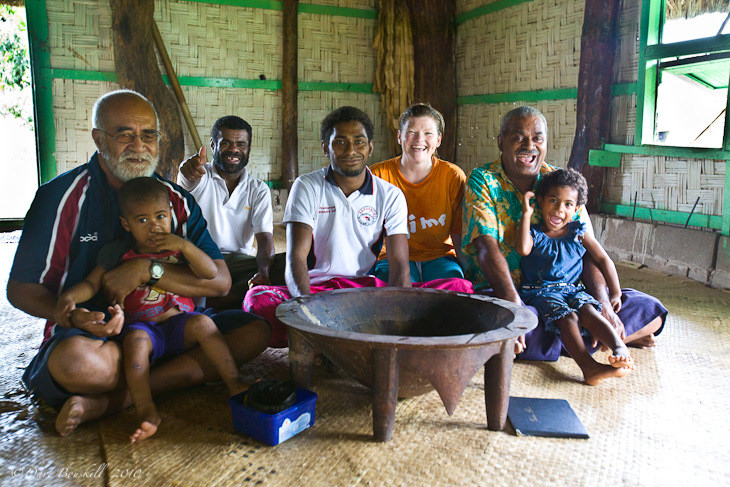1. Introduction
This article highlights an adventurous visit to the Tao Village and the captivating Oho Caves in Fiji. The experience immerses visitors in the local culture and history, providing a unique glimpse into the traditional lifestyle of the local tribes.
2. Journey to Tao Village
It was a last minute schedule change that took us on a Tao Village visit to the Oho Caves in Fiji.
We were looking to squeeze in one more adventure during our stay on the main island, and we found just the thing.
The Tao Village has recently allowed tourists into their village for visits, and their sacred Oho Caves are the star attraction.
We took an hour-long drive from the Outrigger Lagoon Resort on the Coral Coast through a very wet yet green countryside on a very bumpy gravel road.
Our driver, Vincent, mentioned that he was to take the old van, as the roads were too rough for the newer models.
Tao Village Fiji
People greeted us with curious smiles as we arrived at the village, and we sensed that they don’t see many tourists in this part of the island.
Our guide, Ratulevu, joined us in the van and we drove to the trail entrance to begin the half-hour hike to discover the well-hidden Oho Caves.
As he lifted the barbed wire off its nail and spoke to us about the history of cannibalism, reality set in, and we realized we were in a unique location.
The Hike to Oho Caves
It was a short hike, but it was a tough hike.
Neighboring tribes never conquered the Oho Caves, and the Navatua Tribe was known as one of the fiercest in the land.
They occupied a strategic location, and these caves served as their sanctuary. They could see the entire valley below, and the trail was completely camouflaged. Without our guide, we would never have located it.
Ratulevu shared fascinating stories of how the people of Tao Village are descendants of the Navatua Tribe, known for being the first in the area to embrace Christianity.
Before the missionaries arrived, the Navatua Tribe engaged in warfare with other villages, attacking when the time was right. Ratulevu pointed out the bark they used to boil, revealing the significance behind its color. If the water turned red, it meant victory in battle; if not, they wouldn’t proceed.
According to him, it must have worked because the Navatua Tribe was never conquered.
You didn’t want to lose a battle in those days because the losers ended up on the dinner plate.
Discovering the Oho Caves
The caves seemed to appear suddenly, revealing an awe-inspiring sight.
The chamber was much larger than we envisioned, bright and inviting. We took a moment to absorb the beauty before venturing further inside.
Ratulevu dashed ahead, climbing to the throne where the chief once sat high above his people—a precarious perch that was intimidating to envision.
A creepy atmosphere enveloped us as we approached the cooking area. He described how this spot was strategically chosen so that smoke could escape unnoticed through the hole above.
No one wanted to reveal their location through a plume of smoke, as it would beckon an attack.
Ratulevu also pointed out where prisoners were executed, right beside the fire where they were cooked—a chilling reminder of the history here.
We ventured deeper into the cave in search of bats, and as Ratulevu illuminated the ceiling with his bright light, the bats began to circle closer, signaling our cue to leave.
Kava Ceremony Experience
When visiting any village, participating in a Kava ceremony is customary. We felt unprepared to discover that we would be joining the executive heads of the Tao Village. We hadn’t brought any Kava root or dressed appropriately, mistaking the trip for a simple cave exploration.
However, the Chief and his second in command were gracious and welcoming, performing the ceremony and inviting us into their bure (house) as friends.
We partook in two high tides (full cups of Kava) and engaged in conversation about their unique way of life, living traditionally in a world that is rapidly changing.
Time slipped away as we connected with them—they were warm, friendly, and genuinely open about their experiences.
The Promised Return
Unfortunately, we had time constraints that prevented us from fully savoring our experience. This is often the downside of media trips; while it’s incredible to see so much in a short window, it can feel rushed, leaving you yearning for more.
Nonetheless, we promised to return upon our next visit to Fiji and exchanged contact information, as our guide Ratulevu has embraced modern communication.
We genuinely hope that more people discover the Oho Cave Tour. It was one of the most authentic and genuine experiences during our time in Fiji. Among all our encounters with local villages, the Oho Cave and Tao Village Tour felt particularly intimate and special.
Tips for Visiting a Village in Fiji
- The Oho Caves Tour can be arranged through your hotel.
- Bring hiking shoes, insect repellent, and water.
- Carry a Sulu (sarong) for the tea ceremony.
- Purchase Kava root from the local market beforehand.
- Allocate an entire morning for the visit, ensuring return to your hotel after lunch.
Travel Planning Resources
Looking to plan your next trip? Here are some tested resources:
Flights: Start planning your journey by finding optimal flight deals on Skyscanner, which has been our go-to for years!
Hotels: For hotel pricing, use Booking.com if you’re in Europe, or TripAdvisor if you’re elsewhere.
Apartment Rentals: Seek budget-friendly apartment rentals through VRBO.
Travel Insurance: Always essential, consider Safety Wing for occasional travelers or Medjet for global air medical transport and security.
Activities: For walking tours and skip-the-line tickets, explore Get Your Guide.





